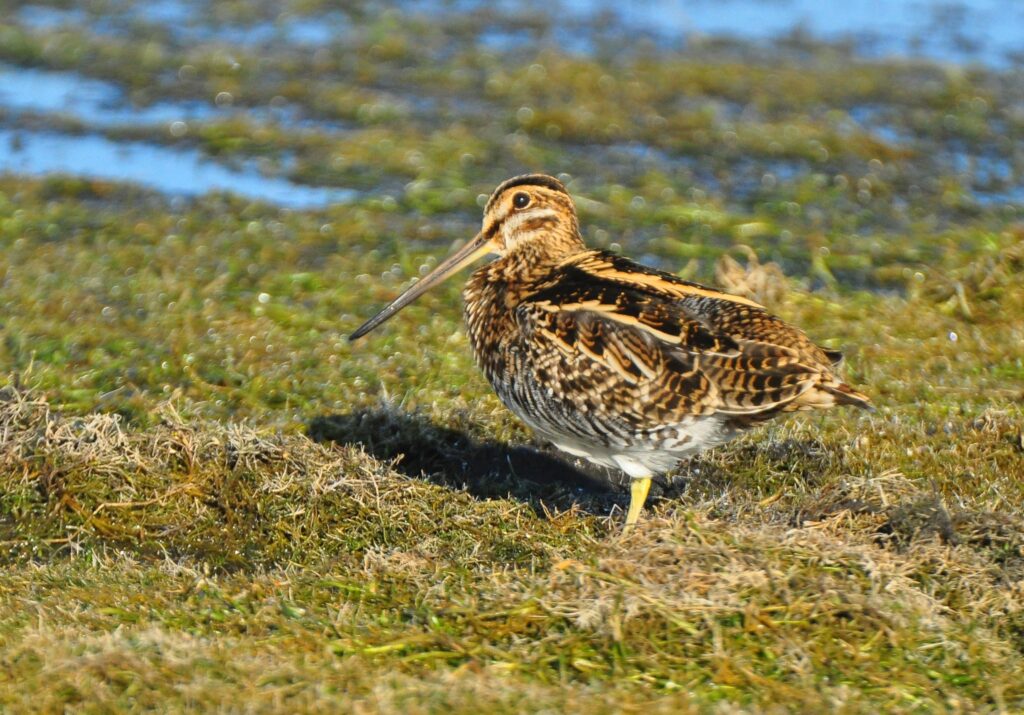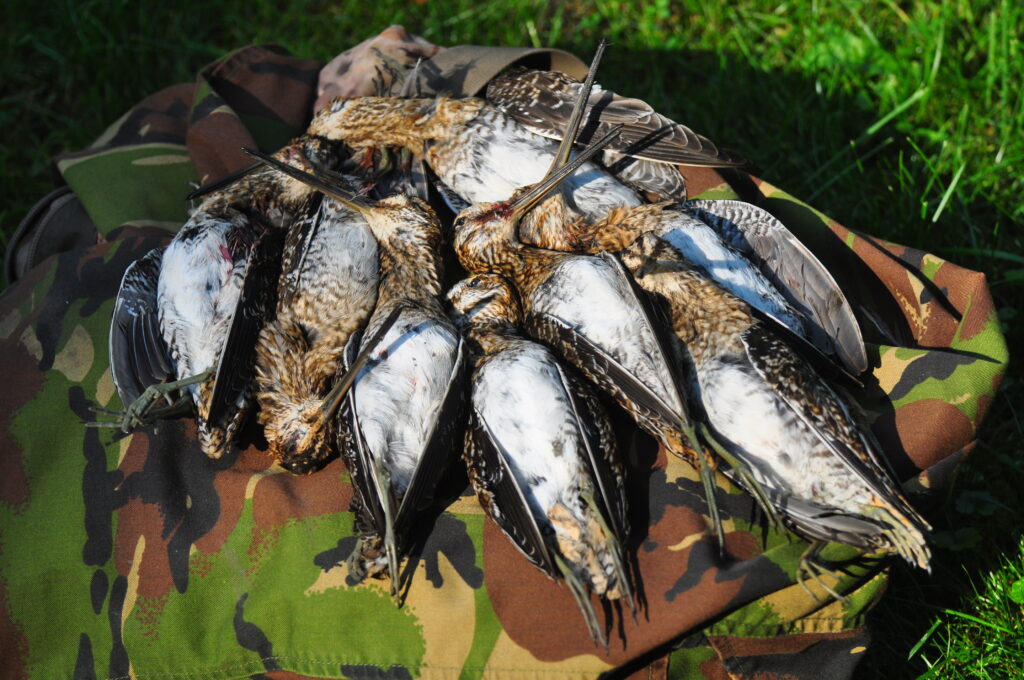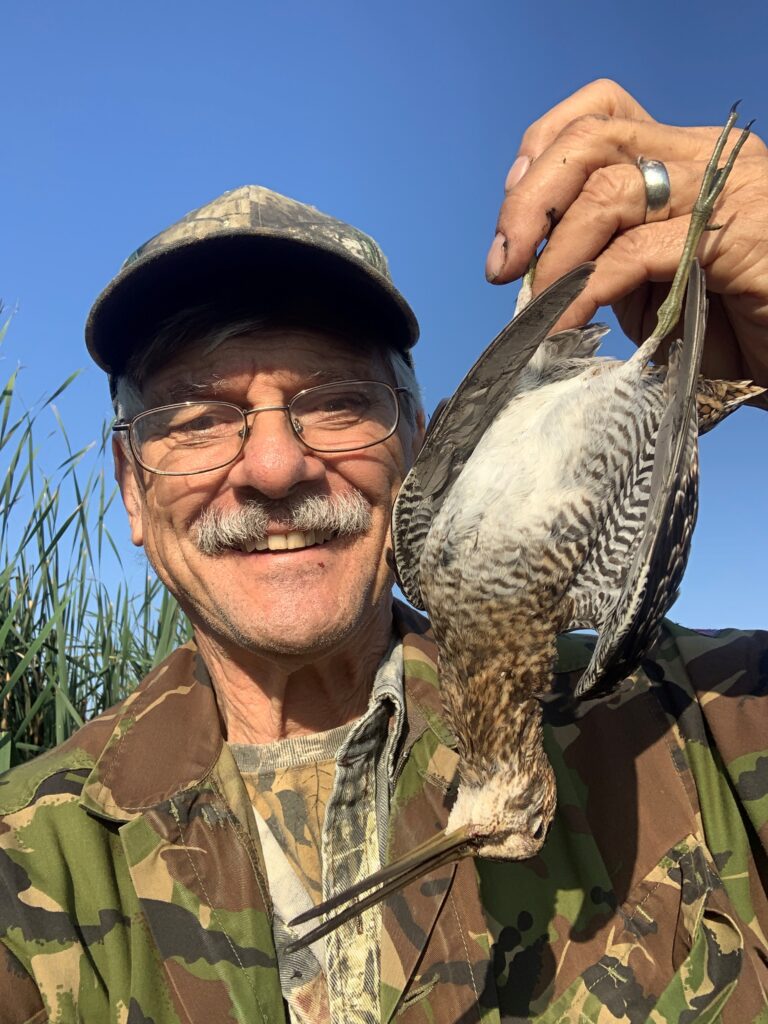Photography courtesy of Lowell Washburn, all rights reserved.
For most folks, the words ‘Snipe Hunt’ will bring to mind one of the world’s most famous practical jokes. The joke takes place when a naive newcomer is taken to a spooky, nighttime marshland where he is handed a lantern and empty gunny sack. The victim is then instructed to hold the glowing lantern in front of the open gunny bag while whistling to yet unseen flocks of snipe. As the newbie begins whistling, the remaining members of the party announce they are heading to the far end of the marsh for the purpose of driving the birds back toward the lantern. The unsuspecting rube is assured that as soon as the fleeing birds hear the whistling and see the light, they will fly directly into the sack. It might take a while, but by the time the party returns, the bag should be chock full of fluttering snipe.

This never happens, of course. Instead of going to the other end of marsh, group members immediately return to their trucks and head for town. The newbie is literally left holding the bag and, upon eventually realizing the ruse, makes the long and embarrassing walk home. With friends like that, huh?
As a teenager growing up on the Missouri River, my grandfather, Everett Washburn, became the intended victim of just such a hunt. In this particular instance, however, he was already well aware of the famous prank. Deciding to play along, Grandpa went to the swamp, received his instructions, and was dutifully whistling and holding the lantern when his older friends headed out to haze the snipe.
In those days, the Missouri River floodplain was largely undeveloped and there were a myriad of winding dirt roadways between the swamp and the General Mercantile where the Good ‘ol Boys planned to reconvene for a good laugh. The Mercantile stayed open Saturday nights and, just as soon as his friends disappeared into the night, Grandpa hightailed it for town. As it turned out, he was actually able to beat the pranksters back to the mercantile, mainly due slow travel on the twisty, switchback mud roads.
Taking a seat in a dimly lit corner, Grandpa watched and listened as the returning group gathered around the pot-bellied stove for a good laugh. The guffaws came to an abrupt halt when Grandpa finally revealed himself. The joke was on the jokesters and the story was oft repeated until Grandpa left Missouri to join the military at the beginning of WW1.
It’s been more than a century since Grandpa participated in that Missouri snipe hunt. But even today, it is amazing how many people still believe the snipe is a made-up creature, a bird existing only in the folklore of a practical joke.
But the snipe is indeed a real, honest-to-goodness wild bird — a secretive, long-billed, member of the shorebird family which, during fall migrations, may be sitting closer than you think.

Famous for its speedy flight and zig zagging maneuvers, the snipe is an abundant and ultra challenging gamebird. The snipe’s darting flight makes it so difficult for shotgunners to bag that, back in the 1700s, the British army coined the word ‘sniper’ to describe marksmen possessing the expertise to consistently connect with this elusive target.
My introduction to the joys of snipe hunting occurred during the 1960s. Strapping on hip boots and loading our pockets with shells, my high school friends and I would tackle the boot sucking mud of local mudflats and marshlands in search of these elusive birds. Utilizing their cryptic plumage to remain undetected, the long-billed ‘bog quail’ would flatten and hold until the very last second. Finally losing their nerve, the snipe would flush while uttering their characteristic “scaipe” alarm call. Once airborne, the snipe seemed to go from zero to sixty in about one second flat. Tracking their erratic flight with a shotgun barrel was nearly impossible. In most cases, I zigged just as the fleeing bird zagged, leaving my shot charge to kick up an empty spray of mud and water in the spot where the snipe had just been. Compared to rabbits, squirrels, pheasants, and ducks; snipe proved to be downright frustrating.
Although most of my shots were misses, I did manage to occasionally bag a bird or two and I considered each one to be a trophy. Within a few seasons, my score was improving, and I felt like I was starting to get the hang of it. The zenith of my snipe hunting career occurred sometime around 1975 when a giant snapping turtle fell into the water control structure at Cerro Gordo County’s Zirbel Slough. In its concerted effort to exit the tube, the powerful reptile had managed to dislodge some of the structure’s control boards, lowering the marsh’s water level by at least four or five inches before the damage was discovered. The result was a large and oozy mudflat forming along the northern portion of the marsh. The buffet was set; within days the food rich flat had attracted hundreds of snipe. There were so many of the birds that whenever a snipe-hunting harrier or sharp-shinned hawk appeared, the flat would immediately erupt with an audible roar of wings. For the next few minutes, the skies above the marsh would resemble a beehive as disorganized clouds of snipe circled and recircled before dropping back to feed.
Taking advantage of what we knew to be a temporary situation, my dad and I began making frequent after-work excursions to the snipe laden mudflat. We usually bagged several birds per outing; and occasionally took our eight-bird limits. The early October migration was at its peak and, in spite of the pressure, the number of snipe we encountered seemed to increase with each visit.
My friend, Ed Kotz had recently given me a lightweight 20-gauge Remington Wingmaster, which turned out to be the perfect shotgun for hunting snipe. Arriving back at the slough one late afternoon, dad and I began crossing the flat. The action was immediate with close range snipe flushing right and left, which had become par for the course. But what was unusual that afternoon was my shooting. For whatever the reason, I just couldn’t seem to miss no matter how fast or erratically a snipe would fly. Although those who have actually witnessed my gun handling may find it hard to believe, I went eight for eight that day. For the first time in my life, I had attained a beautiful full limit of snipe without a single miss.

So how out of the ordinary was that benchmark event? All I can say is that try as I might, I have never once been able to duplicate that perfect limit during any of the 48 seasons that have followed that day. But that’s OK. As long as the snipe keep flying and as long as my legs can handle the boot-sucking mud, I’ll keep on enjoying the day — regardless of how many birds I miss.

FROM MARSH TO TABLE
Abundant, challenging, and underutilized, the Wilson’s snipe is one the most deliciously flavorful gamebirds the outdoors has to offer. I love snipe hunting and pursue the bird whenever I can. I’ve conducted eleven outings so far this season, and the continuing migration has been incredible.
Weighing in at 3 ½ to 4 ounces, snipe are small and it usually takes about three birds to make a good serving. But whatever the species may lack in size is certainly compensated for in table quality. Snipe are best when served whole and can be fried, baked, or grilled. Although I prefer my snipe a bit on the pink side, the bird is somewhat unique in that it can be cooked all the way from rare to medium-well without compromising its distinctive flavor. No matter how you cook them, snipe are delicious!

In addition to grilled snipe, my favorite plate also includes a generous side of wild rice. Speaking of sides, this year’s crop of wild plums is currently achieving peak sweetness – so ripe that when you touch one plum, four or five others fall to the ground. Most public wetlands contain one or two healthy plum thickets, and you won’t want to miss the opportunity to add some fresh sweet & spicy plum sauce to your snipe and rice entrée. Bon Appetit!


 Susan Judkins Josten
Susan Judkins Josten Rudi Roeslein
Rudi Roeslein Elyssa McFarland
Elyssa McFarland Mark Langgin
Mark Langgin Adam Janke
Adam Janke Joe Henry
Joe Henry Sue Wilkinson
Sue Wilkinson Tom Cope
Tom Cope Kristin Ashenbrenner
Kristin Ashenbrenner Joe Wilkinson
Joe Wilkinson Dr. Tammy Mildenstein
Dr. Tammy Mildenstein Sean McMahon
Sean McMahon